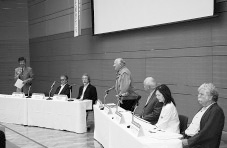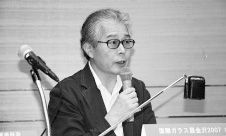This 10th Anniversary International Exhibition of Glass Kanazawa 2007 drew 456 works from 35 nations and regions. At the Preliminary Slide Assessment on April 25, 2007, 74 works from 20 countries were selected. Then 73 works from 19 countries were sent to us.
At the Final Assessment on July 12, 2007 all the prize winners were selected.
This Special Round Table Discussion held on July 13,2007provided an opportunity to report the result of the Final Assessment. Each juror made comments on the prize winners and made advice for the young participants. The Grand Prize winner, the 10th Anniversary Special Prize winner, and the Gold Prize winner were displayed in the middle of the meeting room. Around the winners were all the participants and jurors. Other winners were introduced on the screen.
| Date and Time | July 13, 2007 10:00 am~12:00 noon |
|---|
| Venue | Conference Hall New Building, Ishikawa Industrial Center |
|---|
| Panelists | Atsushi Takeda Professor Ryotokuji University , Art Critic / Japan Jiri Harcuba Glass Artist / Czech Republic Joel Philip Myers Glass Artist / USA Jorgen Schou-Christensen Glass Critic / Denmark Naoto Yokoyama Glass Artist / Japan |
|---|
| MC | Kazuo Boda Deputy Chairperson, Executive Committee The International Exhibition of Glass Kanazawa Managing Director, Design Center Ishikawa |
|---|
| Interpreter | Yoshiko Hayakawa Conference Interpreter |
|---|
Opening and Introduction
 Boda(MC) Good morning ladies and gentlemen. We would like to begin the Special Symposium or the Round Table Discussion for the International Exhibition of Glass Kanazawa 2007.
Boda(MC) Good morning ladies and gentlemen. We would like to begin the Special Symposium or the Round Table Discussion for the International Exhibition of Glass Kanazawa 2007.
I’m Kazuo Boda, the Managing Director of the Design Center Ishikawa and the Deputy Chairperson of the Executive Committee of the Exhibition. I hope this Round Table Discussion will be an opportunity for you to talk casually with each other.
I’d like to introduce all the jurors.
This is Atsushi Takeda, an art critic. This is Naoto Yokoyama, a glass artist. Next this is Jiri Harcuba from Czech Republic. Next this is Jorgen Schou-Christensen from Denmark. And this is Joel Phillip Myers from the US. All the jurors, thank you very much for coming to Kanazawa all the way from your countries. I’d like to thank you again for judging works at the Final Assessment. Ms Yoshiko Hayakawa will be our interpreter.
Report on the Procedure
Boda(MC) We’d like to explain the outline of the exhibition.
This time 456 works were submitted from 35 nations and regions.
On April 25, 2007 the Preliminary Slide Assessment was performed with four jurors, Atsushi Takeda, Jun fujita, Chairperson of the Japan Glass Artcrafts Association, Yoriko Mizuta from the Hokkaido Museum of Modern Art, and Ryoichi Komatsu, the Director of the Kanazawa Utatsuyama Crafts Workshop Center and the Deputy Chairperson of the Design Center Ishikawa.
The assessment was very strict and severe, and 74 works from 20countries were selected. Then 73 works were sent to us for the Final Assessment held yesterday.
At the Final Assessment held yesterday all the prize winners were selected. It was a difficult task for the jurors to select limited number of winners out of many excellent works. The Grand Prize winner, the Gold Prize winner and the 10th Anniversary Special Prize winner are displayed just in front of you. Other prize winners are in the list on the table and they will be on the screen. We’d like Atsushi Takeda to be a modulator for the discussion. We’d like him to briefly report the Preliminary Slide Assessment. Then comments on the works will be from each juror. At the end each juror will make comments on the Final Assessment and advice and opinions for young artists.
Result of the Assessments
 Takeda Good morning ladies and gentleman. Thank you for the kind introduction. I’ll be a modulator for this symposium and ask each juror of the Panel to explain the winners and make comments on the Final Assessment. And then I’ll move to the questions and answers time, which is the most important part and in which all the jurors look forward to talking with you. I hope we’ll receive open
opinions and questions from the participants.
Takeda Good morning ladies and gentleman. Thank you for the kind introduction. I’ll be a modulator for this symposium and ask each juror of the Panel to explain the winners and make comments on the Final Assessment. And then I’ll move to the questions and answers time, which is the most important part and in which all the jurors look forward to talking with you. I hope we’ll receive open
opinions and questions from the participants.
First, I’ll report briefly the result of the Preliminary Slide Assessment held in April by four jurors. At first we looked at all the slides in order to grasp the level of the submitted works. Then we had a rest and once again we looked at the slides listening to each juror’s opinions. We devided the works into three groups, works to be selected, works to be pending, and works not to be selected.
As a result, the number of works in the first category was more than that of the planned. So at the second session of the slide assessment we carefully checked the works again.
As you know it is hard to imagine what the work is really like only by looking at it on its slides. Particularly in the case of glass, lighting plays an important role in appealing each work. So we had to judge by imagining each work in natural light based on each juror’s experiences in the past. Another important factor is the size of each work. It is difficult to imagine the real sizes only by looking at a work on the slides. And also the size often changes the image of a work. So we asked the staff of the secretariat to tell us precisely of each size of each work and we performed our judgement while reading the comments from the artists.
As to the works to be pending, we looked at them again and discussed them and selected some of them which are worth being selected. Finally the number of the works to be selected become close to 70. During the assessment, we spent the whole day exchanging our opinions. It is natural that the four jurors have their own values and own ways of jurying each work and have different opinions. It seldom happened that all the jurors said “yes”. So we tried to understand each juror’s insistence and finally decided the works to be selected and not to be selected.
Yesterday I looked at the selected works for the first time at the venue of the Final Assessment and I felt happy and lucky as one of the jurors at the Preliminary Slide Assessment because I received from quite a few people their statement
t excellent works were selected. They even said that the works look the same as those on their slides and that some of the works are still better and more powerful.
Next I’d like to tell you briefly about the Final Assessment held yesterday. All the jurors of the Panel participated in the Final Assessment. The judging procedure was proposed by the Secretariat ; each juror has three 10-point –cards and five 5-point –cards and gives each point card to an excellent work he wants to award. First we decided to select prize winners from the Grand Prize, the 10th Anniversary Special Prize, the Gold Prize, the Silver Prizes and the Honorary Mentions.
By selecting the best three works, we got to know what level of works could be appreciated. Then it turned out that the five works by five artists had received the highest score, 25 points. Standing in front of those five works, we exchanged open opinions, because we had decided to value discussion and not to decide the winners only by tallying the scores.
As a result, the best three prize winners were selected. Then we selected the four Silver Prize winners including the work with 25 points which could have been selected as the Gold Prize winner. Then we selected six Honorary Mention winners including the works with 20 points and 15 points. Those winners were also decided after all the jurors spent a long time discussing and discussing.
The works which received 25 points are so excellent that it was quite difficult to decide which of those should be awarded which prize. One of them is a work submitted from Germany and only one of the pair was sent to us although the original work had a pair because of the limitation of the size as a condition. We know that the similar work of this artist’s was awarded quite big prize in Germany.
That’s why we eliminated this work out of the best five works and decided to give it the Silver Prize. Then selecting the best three works out of the four, particularly selecting the Gold Prize winner was very difficult. The Gold Prize went to Trnka’s work finally after it was competed with Tsukada’s work.
It couldn’t be helped that Tsukada’s work was not awarded the Gold Prize, instead it was awarded the Silver Prize. Then
the three works with next highest points were also awarded the Silver Prizes.
Then we moved to selecting each juror’s prize. The way of selecting had nothing to do with the previous voting nor discussion. The criteria of selecting is also left to each juror. Thus each juror’s prize winner was decided. Unlike the other prize winners, very interesting works were selected because each juror had his own emotional responses to the winner.
In that way, all the eighteen prize winners were decided. We had so many opinions that I was a little worried whether or not we could finish the Final Assessment within yesterday. However, once we started the assessment, it went smoothly in a good mood. At the end of the assessment, I had to adjust different opinions from jurors, yet it was fair that each juror insisted his own ideas and opinions by explaining the reasons for his judging. I was in charge of the head juror of the assessment panel, so I was happy that the Final Assessment was over before 2:00 PM.

